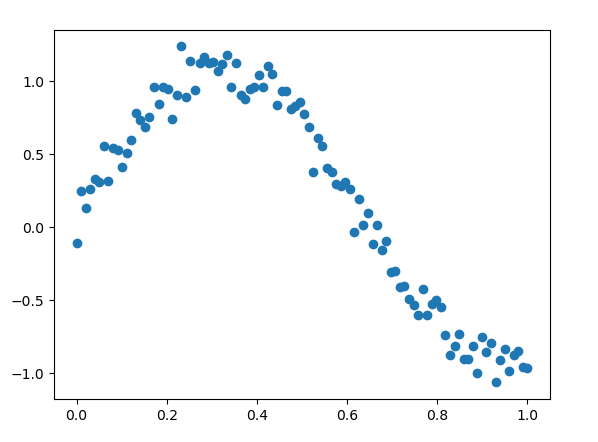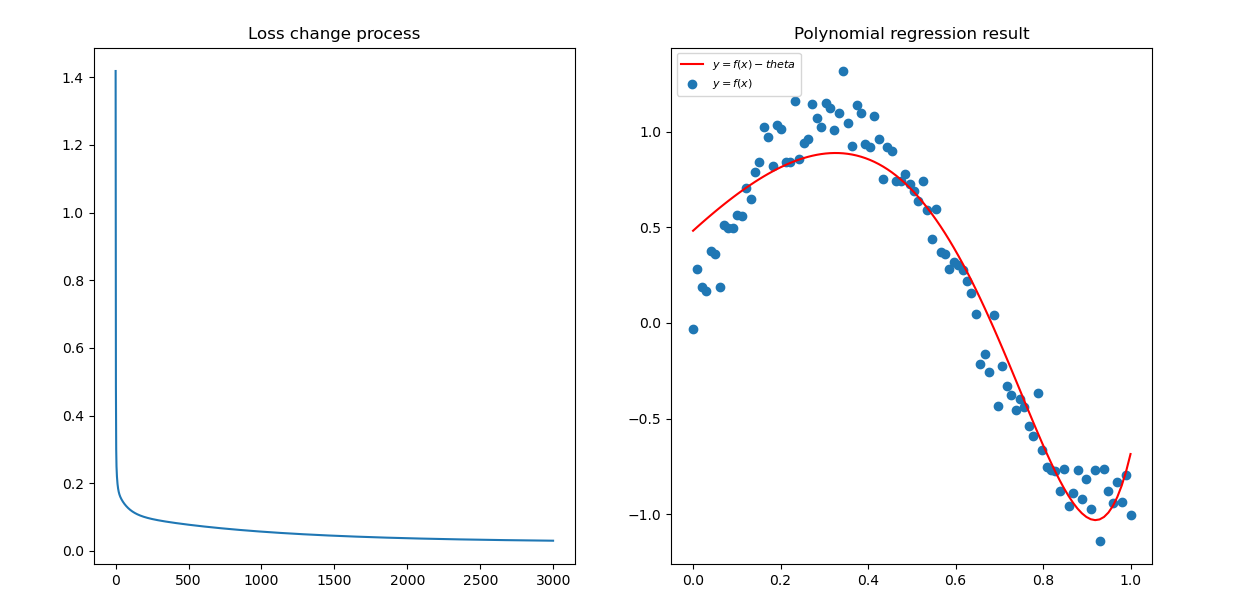numpy实现多项式回归模型
目录
前言
书接上回,上回我们介绍了线性回归,这次我们来关注一下多项式回归。
对于多项式回归,回归函数是回归变量多项式的回归 ,实际上线性回归是多项式回归中的特殊情况,即此自变量的项次是一次。
原理
泰勒公式告诉我们,任何函数在一定区间内都可以用多项式函数进行逼近,即

假设我们的n=1,那么我们就回到了线性模型。
理论上我们的n越大,我们的函数就更加逼近原函数,不过在实际运算中,该值越大,计算量也就越大,而且计算机运算过程中也容易溢出,因此该值应该有一个比较符合实际意义的值。
参照上文,我们可以写出损失函数为:

该函数对每一项的系数求导为:

更新参数方法依旧是使用梯度下降分析法:

代码实现
我们先产生一个三角函数的数据,并加入随机偏差,模拟非线性数据:
def Data():
x = np.linspace(0, 1, 100)
y = np.sin(5 * x) + 0.1 + np.random.randn(len(x)) * 0.1
return x, y

再定义参数初始化函数:
def init(len=5):
"""
len 是多项式次数,该函数返回多项式的每一个系数
"""
return np.random.randn(len) * 0.5
接下来就是我们的回归主体部分啦!
在这之前,我们来学习一下怎么使用NumPy来实现多项式计算:在NumPy中,如果我们要计算:
f(x) = a + b * x + c * x^2 + d * x^3
可以使用:
f = np.poly1d(theta)
f(x)
其中,theta是多项式系数,例如计算f(x)=0.7 * x^2+ 0.6 * x + 0.5在x=1.2的值,可以用下面的代码完成:
f = np.poly1d([0.7, 0.6, 0.5])
f(1.2)
2.2279999999999998
记住,np.poly1d()中的参数是从多项式最高项开始的
因此我们可以定义计算y_hat的函数:
def getY_Hat(x, theta):
# 根据 theta 作为系数,生成多项式函数
f = np.poly1d(theta)
return f(x)
有了该函数后,我们可以继续定义loss函数:
def loss(y, yHat):
n = len(y)
t1 = (y - yHat) * (y - yHat)
return sum(t1) / n
梯度下降分析法:
# 更新每一个参数
n = len(theta)
for j in range(n):
sm = sum((y_hat - y) * (x ** (n - 1 - j)))
roundThetaIdx = 2 * sm / n
theta[j] = theta[j] - learning_rate * roundThetaIdx
最终的结果:

完整代码
# -*- coding: utf-8 -*-
"""
Created on Tue Apr 12 17:47:32 2022
@author: YaleXin
"""
import numpy as np
import matplotlib.pyplot as plt
#%%
def Data():
x = np.linspace(0, 1, 100)
y = np.sin(5 * x) + 0.1 + np.random.randn(len(x)) * 0.1
return x, y
#%%
def init(len=5):
"""
len 是多项式次数
"""
return np.random.randn(len) * 0.5
#%%
def getY_Hat(x, theta):
# 根据 theta 作为系数,生成多项式函数
f = np.poly1d(theta)
return f(x)
#%%
def loss(y, yHat):
n = len(y)
t1 = (y - yHat) * (y - yHat)
return sum(t1) / n
#%%
def PolynomialRegression(x, y, theta, ax, epoch=100, learning_rate = 0.01):
"""
梯度下降法
"""
ax.set_title("Loss change process")
loss_x = []
loss_y = []
for i in range(epoch):
y_hat = getY_Hat(x, theta)
lst = loss(y, y_hat)
loss_x.append(i)
loss_y.append(lst)
print("lost = " + str(lst))
# 更新每一个参数
n = len(theta)
for j in range(n):
sm = sum((y_hat - y) * (x ** (n - 1 - j)))
roundThetaIdx = 2 * sm / n
theta[j] = theta[j] - learning_rate * roundThetaIdx
ax.plot(loss_x, loss_y)
return theta
#%%
def plotAns(x, y, Y, ax):
"""绘制图形
y是数据原始的y值,Y是拟合得到的值
"""
ax.set_title('Polynomial regression result')
ax.scatter(x, y, label = r'$y = f(x)$')
ax.plot(x, Y, label=r'$y = f(x)-theta $', color='red')
ax.legend(loc='upper left',prop={'family':'SimHei','size':8})
#%%
if __name__ == "__main__":
fig = plt.figure()
cost_ax = fig.add_subplot(1,2,1)
ans_ax = fig.add_subplot(1,2,2)
# 载入多项式回归数据
x, y = Data()
# 初始化 最高次数为 10 的一组系数
theta = init(10)
# 设置学习率
my_learning_rate = 0.02
# # 求解最优参数
theta = PolynomialRegression(x, y, theta, cost_ax,epoch=3000)
f = np.poly1d(theta)
yhat = f(x)
plotAns(x, y, yhat, ans_ax)
plt.show()
本文由「黄阿信」创作,创作不易,请多支持。
如果您觉得本文写得不错,那就点一下「赞赏」请我喝杯咖啡~
商业转载请联系作者获得授权,非商业转载请附上原文出处及本链接。
关注公众号,获取最新动态!
历史评论
开始评论

